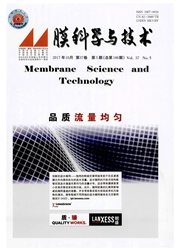

 中文摘要:
中文摘要:
为了改善膜的分离性能,采用氧化石墨烯(GO)与纳米二氧化钛(nano-TiO_2)对聚醚砜(PES)超滤膜进行共混改性,将GO和nano-TiO_2单独或按比例添加到PES铸膜液中,分别考察了不同共混改性超滤膜分离性能和抗污染性能,并通过热失重分析仪等表征手段对膜进行了分析,利用纯水和模拟污染物进行了通量测试。试验结果表明:共混改性后超滤膜热稳定性增强,指状孔道变大,上表面粗糙度减小.通过对比分析,可知GO和nano-TiO_2共同共混改性的超滤膜(0.8%GO+0.2%nano-TiO_2)性能最优,纯水通量可达260L/(m2·h),相较于纯PES膜,通量增加了52.1%,静态接触角可达54.7°,BSA和SA模拟污染物过滤180min后,膜的稳定通量分别保持在67.8和68.0L/(m2·h)左右,截留率均可达99%以上.
 英文摘要:
英文摘要:
In order to improve the separation performance of ultrafiltration(UF)membranes,PES UF membranes were modified by blending with nano-TiO_2 and graphene oxide in this paper.The casting solution of PES was blended with GO and nano-TiO_2 or either of them in different loading,and the separation performance and anti-fouling ability of the modified membranes were investigated.The modified membranes were characterized by the analysis methods such as thermal gravity. The water flux measurements were conducted by using the pure water and simulated foulant solution.The results showed that the thermal stability was improved,the mean pore size was increased,and the surface roughness was smaller than that of the pure membranes.Compared to another blending modification reports,the PES ultrafiltration membrane loading GO and nano-TiO_2(0.8%GO+0.2%nano-TiO_2)have the optimal performance in permeability.The pure water flux of the membrane with 0.8%GO+0.2%nano-TiO_2 reached 260L/(m2·h),up to 52.1% higher than pristine ultrafiltration membrane,and the contact angle reached 54.7°.During the 180min′s filtration tests of BSA and SA solution,the stable flux reached 67.8and 68.0L/(m2·h)respectively,and both of the rejections were more than 99%.
 同期刊论文项目
同期刊论文项目
 同项目期刊论文
同项目期刊论文
 期刊信息
期刊信息
